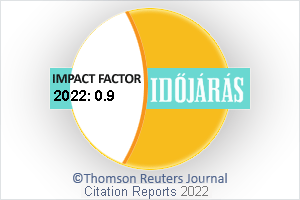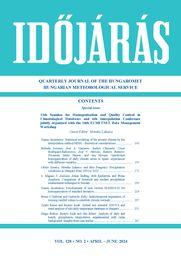Időjárás - Quarterly Journal of the Hungarian Meteorological Service (OMSZ)
Vol. 128, No. 2 * Pages 143–286 * April - June 2024
 download [pdf: 22979 KB]
download [pdf: 22979 KB]
Statistical modeling of the present climate by the interpolation method MISH – theoretical considerations
Tamás Szentimrey
DOI:10.28974/idojaras.2024.2.1 (pp. 143–154)
Tamás Szentimrey
DOI:10.28974/idojaras.2024.2.1 (pp. 143–154)
Operational homogenization of daily climate series in Spain: experiences with different variables
Belinda Lorenzo, José A. Guijarro, Andrés Chazarra, César Rodríguez-Ballesteros, José V. Moreno, Ramiro Romero-Fresneda, Maite Huarte, and Ana Morata
DOI:10.28974/idojaras.2024.2.2 (pp. 155–170)
Belinda Lorenzo, José A. Guijarro, Andrés Chazarra, César Rodríguez-Ballesteros, José V. Moreno, Ramiro Romero-Fresneda, Maite Huarte, and Ana Morata
DOI:10.28974/idojaras.2024.2.2 (pp. 155–170)
Precipitation conditions in Hungary from 1854 to 2022
Olivér Szentes, Mónika Lakatos, and Rita Pongrácz
DOI:10.28974/idojaras.2024.2.3 (pp. 171–193)
Olivér Szentes, Mónika Lakatos, and Rita Pongrácz
DOI:10.28974/idojaras.2024.2.3 (pp. 171–193)
Comparison of historical and modern precipitation measurement techniques in Sweden
L. Magnus T. Joelsson, Johan Södling, Erik Kjellström, and Weine Josefsson
DOI:10.28974/idojaras.2024.2.4 (pp. 195–218)
L. Magnus T. Joelsson, Johan Södling, Erik Kjellström, and Weine Josefsson
DOI:10.28974/idojaras.2024.2.4 (pp. 195–218)
Development of new version MASHv4.01 for homogenization of standard deviation
Tamás Szentimrey
DOI:10.28974/idojaras.2024.2.5 (pp. 219–235)
Tamás Szentimrey
DOI:10.28974/idojaras.2024.2.5 (pp. 219–235)
Spatiotemporal imputation of missing rainfall values to establish climate normals
Brian O’Sullivan and Gabrielle Kelly
DOI:10.28974/idojaras.2024.2.6 (pp. 237–249)
Brian O’Sullivan and Gabrielle Kelly
DOI:10.28974/idojaras.2024.2.6 (pp. 237–249)
Annual and seasonal ANOVA and trend analysis of sub-daily temperature databases in Hungary
Zsófia Barna and Beatrix Izsák
DOI:10.28974/idojaras.2024.2.7 (pp. 251–266)
Zsófia Barna and Beatrix Izsák
DOI:10.28974/idojaras.2024.2.7 (pp. 251–266)
Analysis of daily and hourly precipitation interpolation supplemented with radar background: Insights from case studies
Kinga Bokros, Beatrix Izsák, and Zita Bihari
DOI:10.28974/idojaras.2024.2.8 (pp. 267–286)
Kinga Bokros, Beatrix Izsák, and Zita Bihari
DOI:10.28974/idojaras.2024.2.8 (pp. 267–286)
IDŐJÁRÁS - Quarterly Journal

Az IDŐJÁRÁS a HungaroMet Nonprofit Zrt. negyedévenként megjelenő angol nyelvű folyóirata
Megrendelhető a journal.idojaras@met.hu címen.
A szerzőknek szánt útmutató itt olvasható.
Megrendelhető a journal.idojaras@met.hu címen.
A szerzőknek szánt útmutató itt olvasható.











